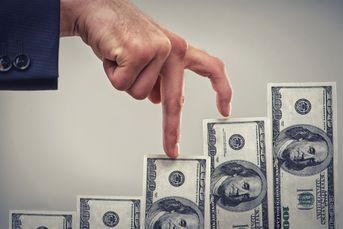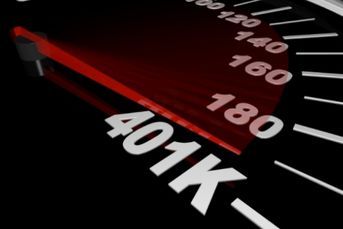Record U.S. stocks at lowest valuation since 1980
P/E ratio for S&P 500 now at 15.4; what's wrong with this picture?
Even though U.S. stocks more than doubled during the four-year bull market, individual investors’ aversion to equities has left companies in the S&P 500 cheaper than at any record high since 1980.
The S&P 500 rose to an all-time closing high of 1,563.23 March 14, up more than 130% from its 2009 lows.
The index trades at 15.4 times reported profit, below the average 19.9 reached in bull markets since 1962, according to data compiled by Bloomberg.
The Dow Jones Industrial Average erased all losses from the financial crisis March 5 and has gained about 11% this year.
Although individuals have added almost $20 billion to U.S. stock funds so far this year, the amount is just 3.5% of the withdrawals since 2007 and compares with $44 billion placed with fixed-income managers in 2013, according to the Investment Company Institute.
For bulls, the absence of private buyers shows that there is plenty of money to keep the rally going.
Bears contend that the pessimism means the rally is too dependent on Federal Reserve stimulus and will fizzle once central bank support ebbs.
“I was down on the floor of the New York Stock Exchange when the Dow hit its new high, and there weren’t any champagne corks popping or people getting excited,” Michael Holland, chairman and founder of Holland & Co., said March 14.
“Valuations are extremely low. When there’s an absence of really bad news, the path of least resistance is up,” said Mr. Holland, whose firm oversees more than $4 billion.
REACHING RECORDS
The S&P 500 has risen about 9% this year. The Dow industrials were trading above 14,530.11 last Wednesday.
In March, the number of Americans filing for jobless benefits fell to the lowest level in almost two months, retail sales increased more than forecast and the housing market strengthened.
Indexes did give back a bit last week as the euro area imposed a levy on Cypriot bank deposits to reduce the cost of rescuing the nation’s lenders.
About $10 trillion has been added to U.S. share values since the market bottomed on March 9, 2009, during the worst financial crisis in seven decades. Confidence among households was shattered by the S&P 500’s 57% plunge from its October 2007 highs.
Institutions have been the main beneficiaries of the rally.
Individuals drained more than $600 billion from equity mutual funds in the six-year period though 2012 before becoming net buyers in January, data from the ICI show.
Even now, private investors remain skittish, withdrawing an estimated $1.7 billion in the two-week period through March 6 and pushing $10.5 billion into bonds.
“This big rotation from bonds to equities is not in full swing,” Alan Zlatar, who helps oversee $65 billion as head of multiasset class investments at Vontobel Asset Management Inc., said March 13.
“Our clients are seeking returns, and so far most of them have tried to stay within the bond space,” he said. “What speaks in favor of equities is, of course, that the alternatives are extremely pricey.”
Stocks are close to the least expensive ever versus government bonds, as measured by a valuation method favored by former Fed Chairman Alan Greenspan that compares earnings with interest payments.
S&P 500 companies currently generate profit equal to 6.5% of their share prices, about 4.5 percentage points more than yields on 10-year Treasuries.
The average spread in the past 10 years was about 2.5 percentage points, data compiled by Bloomberg show.
The combination of stocks being near all-time highs and declining trading volume indicates that money isn’t coming into the market and that equities are rising because fewer people are selling, according to Murray Roos, co-head of European equities at Deutsche Bank AG.
On average, 2.53 billion shares changed hands in S&P 500 companies each day this year, Bloomberg data show. That compares with 3.59 billion between 2009 and 2012.
“There aren’t sellers. That’s why the equity market is looking fundamentally cheap,” Mr. Roos said.
“We’ve got latent demand for equities,” he said. “We are at the start of a protracted move up in equity markets.”
FUELED BY FED STIMULUS
Investors still have reason to be concerned because the rally has been fueled by unprecedented Fed stimulus, according to Stewart Richardson, chief investment officer at RMG Wealth Management LLP.
The central bank has lowered the target interest rate on overnight loans between banks to almost zero and is purchasing $85 billion a month in bonds to boost the economy.
Fed Chairman Ben S. Bernanke’s pledge to spur growth helped stem some of the biggest declines since the bull market began.
The S&P 500 ended a 14% drop and began a 30% advance on Aug. 26, 2010, after he said that he was willing to do everything in his power to stimulate growth.
The index has climbed about 42% since October 2011, the month after Mr. Bernanke announced a policy to replace holdings of short-term Treasuries with longer-term bonds. The S&P 500 had been on the verge of a bear market, down 19.4% over the previous five months.
“The rally has been a direct reflection of Fed policy,” said Mr. Richardson, who oversees $100 million at RMG.
“The low volume means in-vestors are not comfortable or bullish. It is just people putting money to work as they don’t want to hold cash,” Mr. Richardson said.
“As soon as the Fed indicates it will stop printing money, that is a big issue for capital markets,” he said.
HEDGE FUNDS
Although brokerage clients have bought equities this year, professional investors are liquidating some of their stocks, data from Bank of America Corp. clients show.
Institutional managers who oversee money for pensions and other benefit programs had sold a net $2.9 billion of shares through the bank this year, and hedge funds had reduced their holdings by $461 million, according to the BofA report.
“The individual investor doesn’t seem like they’ve come back to the market yet,” said Joseph Veranth, chief investment officer at Dana Investment Advisors Inc., which manages $3.8 billion.
“People aren’t convinced this is for real,” he said. “They’ve been burned twice in a big way, and there’s still doubt.”
Valuations in the S&P 500 have stayed below historical averages though profits have almost doubled since 2009. Per-share earnings are estimated to reach $109.50 this year, up from $61.84 in 2009, according to more than 11,000 analyst forecasts compiled by Bloomberg.
Today’s multiple of 15.4 times reported earnings is up from the bull market’s low of 11.7 in September 2011.
The price-earnings ratio averaged 18.1 in the five-year rally that ended in October 2007 and 20.9 during the gains in the 1990s, data compiled by Bloomberg show.
Although the bull market that began in 1990 started with a multiple about 14, it exceeded 20 within a year.
Valuations during the 2002 advance didn’t fall below the 16.4 historical mean until the cycle’s fourth year, data compiled by Bloomberg show.
The only time stocks were cheaper as the index rallied to a high was in 1980, when they traded for 9.1 times profits.
LEADING COMPANIES
The rise since March 2009 has been led by media companies such as CBS Corp. (CBS) and Gannett Co. Inc. (GCI), and industrial firms including International Paper Co. (IP).
CBS, owner of the most-watched U.S. television network, has jumped more than 15-fold and Gannett, which publishes 82 U.S. daily newspapers and owns 23 television stations, has rallied 11-fold. The share price of International Paper, the world’s largest maker of cardboard packaging, has increased tenfold.
Commodities producers including Cliffs Natural Resources Inc. (CLF) and Tesoro Corp. (TSO) paced gains in the last bull market, which lasted five years through October 2007, data compiled by Bloomberg show.
Technology stocks such as Cisco Systems Inc. (CSCO) and Dell Inc. (DELL) led the rally that ended in March 2000.
“Those investors choosing not to favor equities in their strategy in favor of a bond allocation are locking into low returns,” Ashish Misra, who helps oversee $17 billion as head of investment policy and research for Lloyds TSB Private Banking, said March 13.
“The economic growth outlook has not been this universally constructive for a long time,” he said. “The wall of worry is very much out there for investors to climb before markets seek higher levels and more historically normal ratings.”
–Bloomberg News–
Learn more about reprints and licensing for this article.






